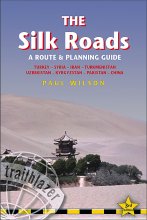Wonderful handbooks
— The Bookseller

The Silk Roads
Excerpt:
Introduction
Contents list | Introduction | Planning your trip | The Middle East - practical information for the visitor | The Silk Road route maps | Sample city guide: Samarkand

For many people the Silk Road conjures up images of caravans of baggage-laden camels ploughing a dusty path across Asia. As the title of this guide suggests, however, the route was never a single superhighway; rather a series of smaller trade paths* which, once united, formed an intricate network between the Occident and the Orient. For over one thousand years it was the most important and best-known trade route in the world, transporting not just silk but all manner of exotic goods such as jade, gunpowder and rhubarb. Just as importantly, this increase in interaction brought about the spread of many ideas, beliefs and technological advances, from the invention of paper to the great religions of Buddhism, Islam and Christianity. Yet it was unusual for an individual traveller to make the entire journey himself; instead, merchants would trade back and forth across their ‘patch’ with goods often changing hands a dozen times before reaching their ultimate destination. Therefore anyone emulating Marco Polo and going the full distance will be creating his or her own little piece of history, joining an exclusive club packed with some of history’s greatest adventurers.
The Silk Roads tie together some of the most fantastic and romantic attractions in Asia and nearly all the sights which made the routes famous have been preserved. From the mosques of Damascus and the archaeological wonders of Palmyra, the routes wound their way past the standing stones of Nemrut Da?i, skirted Persia’s extravagant palaces, trod the Golden Road to Samarkand and joined up with the Great Wall of China. The list goes on and on.
Following the collapse of the Mongol Empire, however, and advances in sea travel, the land routes slipped into neglect and obscurity, synonymous as much with danger as with mythical treasures. It was left to the minds of poets and dreamers to drift eastwards past the once-glorious cities of Esfahan, Khiva, Xi’an and Xanadu, while real-life explorers ran into the innumerable obstacles presented when crossing so many modern, political boundaries. It was only in the early 1990s, following the collapse of the old USSR, that relatively unrestricted travel to Central Asia became viable. Similarly, Syria, Iran and China are once again welcoming independent visitors, while the opening of the Karakorum Highway revived another significant branch of the Silk Road, this time through Pakistan.
Thus, despite September 11 and the war in Iraq, all the countries included in this guide are accessible as never before. We have suggested a series of routes and itineraries in each region to take in as many of the old Silk Roads as possible, making it a unique opportunity to witness the marvels that Asia has to offer, before coachloads of the less adventurous arrive.
* Note: In order not to confuse readers by switching between the Silk Road (singular) and the Silk Roads (plural) when discussing sections of the route or the entire network we have opted for the singular – the Silk Road – throughout, that being the generally accepted form.
Latest tweets